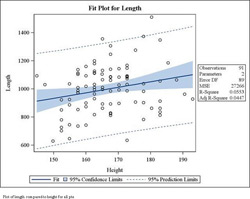|
Back to 2014 Annual Meeting Posters
Small Bowel Length Correlates With Height in Adults: Implications for General Surgery and Gastroenterology
Saju Joseph*1, Jazmine Figueroa-Bodine2, Andrew S. Cruz1, Andrew Tang1, Adrienne Arbour3, Daniel Raines3
1Dept of Surgery, Texas Tech University Health Sciences, Odessa, TX; 2Surgery, St Vincents Medical Center, Bridgeport, CT; 3Gastroenterology, LSU Health Sciences, New Orleans, LA
Introduction: Look in any anatomy textbook and the length of the small bowel (SB) is reported to be roughly 7m. This information is based on data from the 19th century where measurements were done on cadavers, and in those studies the SB length for females was found to be longer than in males. The small bowel length is integral in helping to avoid short gut syndrome during bowel resection and dumping syndrome after gastric bypass. Gastroenterologists are interested in the small bowel length as they attempt "total" enteroscopy. However, there is only a paucity of in vivo SB measurements. We set out to measure the small bowel length of patients undergoing laparotomy to see if variations in length would correlate to height, weight, or sex.
Methods: Measurement of SB length was performed by a single surgeon on 91 patients undergoing laparotomy. The bowel was measured using a sterile 10cm ruler on the anti-mesenteric side with minimal stretch from the ileocecal valve to the ligament of Treitz. Patients with adhesions, previous GI surgery, peritonitis, or laparoscopic procedures were excluded. Demographic data was recorded including height, weight, gender, ethnicity, and reason for laparotomy. Historical data was collected based on all available publications.
Results: In our group there was a wide variation of length (630-1510cm), with the average being 998cm. Linear regression analysis showed a statistically significant relationship between bowel length and patient height. (p=.025) Males had a longer intestinal length than females, (p=0.007).
Data from 12 previous studies, conducted from 1885-2008, were compiled for comparison. A total of 1,730 patients, ranging in age from neonates to 91 years old, were measured using multiple techniques. 565 patients were measured in vivo with 200 of those using radiologic techniques. Seven studies found a correlation between length and patient height, while 6 did not. Seven studies found differences between males and females with 6 finding the length longer in males.
Conclusions: Our study is the largest in vivo study done in the US. We have shown a wide variation in the length of the SB and an average length of 998 cm. Our data also shows a linear correlation between length and patient height, which corroborates previous studies. We have also been able to show differences in length based on gender. We have not been able to differentiate if the differences in SB length are solely due to height or gender. We have also found that the length measurements are very dependent on technique.
We believe that the wide variation of length makes it impossible to predict location or proximity when total enteroscopy is performed. Finally, we recommend that small bowel length be assessed prior to surgical resection or Roux N-Y reconstructions to reduce the risk of dumping syndrome or short gut.

Back to 2014 Annual Meeting Posters
|


